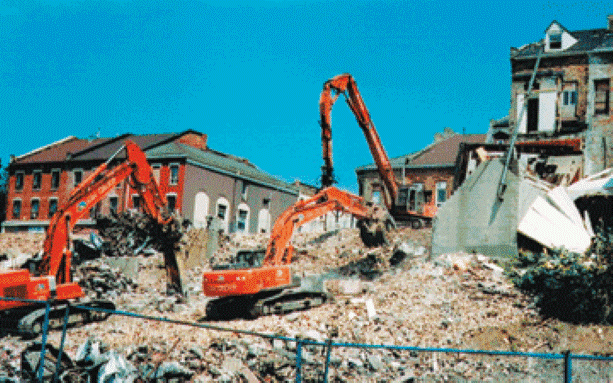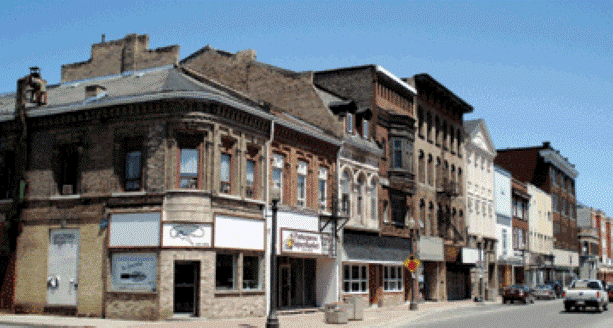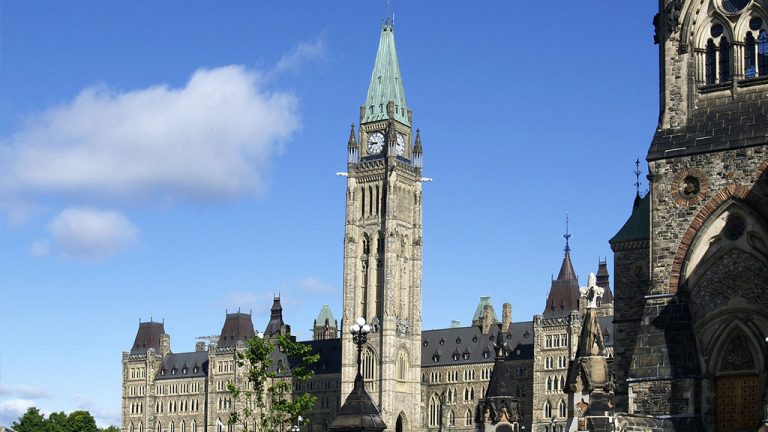A strip of 41 decrepit Confederation-era buildings on the south side of Brantford, Ont.’s Colborne Street were demolished this summer, supported by a $1.38 million federal grant to complete the project.
The strip had been taken over by the city, but became the subject of intense interest by preservationists citing the historical importance of the structures, some of which dated back to 1840.
The buildings, however, were considered by some residents to be remnants of “the worst downtown in Canada” and generally considered to be structurally unsound. Brantford city council efforts to find developers to rehabilitate the strip failed.
The demolition contract of $1.24 million was awarded to AIM Environmental Group of Stoney Creek, Ont. The contractor arrived on the site in February, but delays kept things in limbo as conservationists exhausted various appeals.
“We were on site and able to remove windows and do a lot of the asbestos abatement that would have to be done regardless of what the decision would be,” says Randy Jones, AIM project manager.
“A lot of people thought of these buildings as predating the use of asbestos but there had been a lot of renovation with asbestos floor tile and asbestos wrap used around pipes.”
The buildings were also stripped of copper pipe and ornamental work that could be sold or recycled.
Demolition began on June 6, hours after city council voted 8-3 to raze the buildings.
“The fleet of equipment varied from week to week, but we brought in a 60-foot high-reach excavator and three to four additional excavators to sort wood, crush and pulverize concrete and remove other garbage,” says Jones. A smooth drum compactor and trim dozer rounded out the equipment roster.
The buildings were divided into three blocks according to the two divisions between them. The location of the buildings, however, provided the greatest challenge to safe demolition.
“The buildings front on to Colborne Street, but they back on to Water Street, which sits about 40 feet below Colborne,” says Jones. “Some of the buildings went all the way back to Water. We needed to make sure that the rubble fell into place and the slope remained stable throughout the demolition.”
The street is a major traffic artery and the demolition was well attended by onlookers, so the city provided a full street lane and sidewalk to allow operations. Demolition began in the west end of the block and progressed east, with rubble from one building used to temporarily fill the basement of the next to ensure the slope remained stable throughout the demolition process. Some of the foundations were left in place to maintain the slope and to ensure the stability of Colborne Street.
Jones says the demolition provided no surprises — except in the advanced state of decay of the buildings.
“Even while we were performing asbestos abatement, many of the interiors were so dilapidated and unsafe that we had to delineate areas of the floor where workers weren’t allowed to walk,” he says. “Two of the buildings were considered unsafe to enter.”
Rumours abounded about what was found inside the buildings. The contractor removed the image of an Indian Thunderbird from one of the structures, leading some residents to believe they’d found a vintage Ford Thunderbird inside. Other rumours included the discovery of hidden tunnels leading to a city armoury and a safe full of cash.
“Prior to the demolition there was a lot of negative publicity about pulling the buildings down,” says Jones. “Some people thought that the theatre building was as solid as a rock. The back portion of the theatre had steel beams, but what people couldn’t see was that it no longer had a roof. Once the demo started I think some people were surprised at how easy the buildings fell.” The demolition phase of the project, including scooping out rubble and the introduction of clean fill, was concluded by the end of September. Slope stabilization and remediation was completed by October 21.
Most of the material recovered from the demolition was recycled, with pulverized stone used for a nearby parking lot.
Although there are no firm plans for the block but speculation centers around a YMCA athletic facility or student residences for Wilfrid Laurier University’s Brantford campus.












Recent Comments
comments for this post are closed